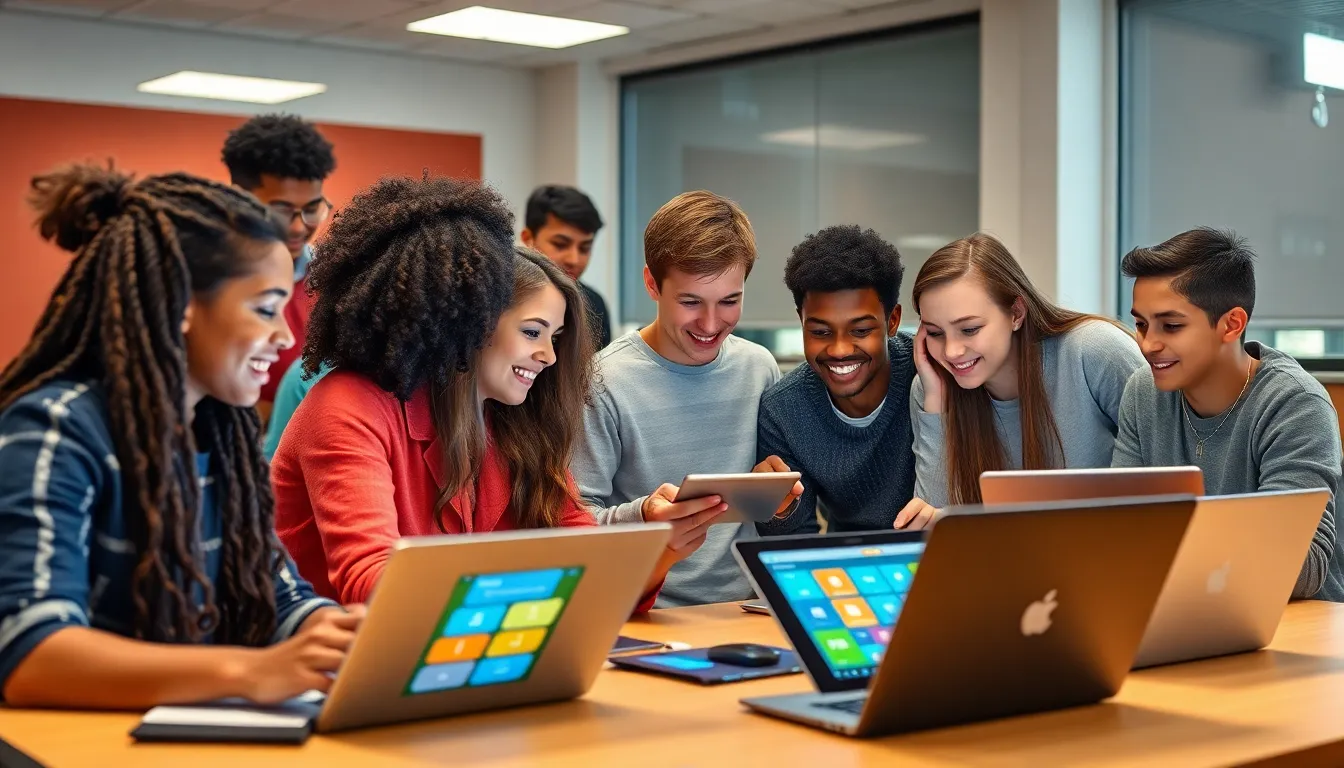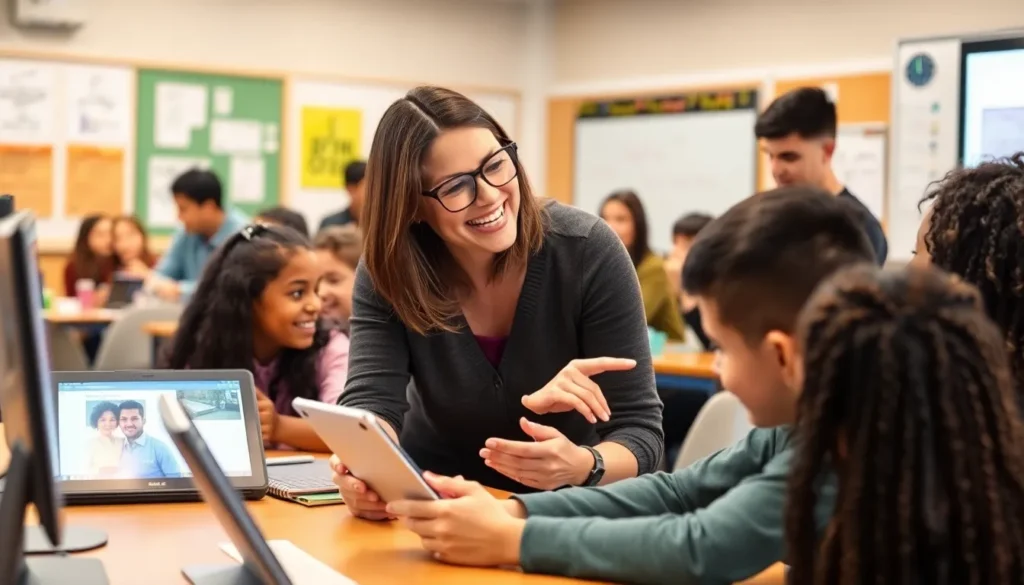In a world where technology reigns supreme, education is no exception. Enter edtech tools—the superheroes of the classroom that swoop in to save the day. They’re not just gadgets; they’re the secret sauce that spices up learning, making it engaging and effective. Imagine a classroom where students are excited to learn and teachers can finally ditch the chalk dust for something a bit more high-tech.
Table of Contents
ToggleOverview of Edtech Tools
Edtech tools transform learning by leveraging technology to create dynamic educational experiences. These resources support various aspects of teaching and learning, making education more accessible and effective.
Definition of Edtech Tools
Edtech tools encompass software applications, platforms, and hardware designed to facilitate learning. Examples include learning management systems (LMS), educational apps, and interactive whiteboards. Such tools streamline lesson planning, enhance student engagement, and provide personalized learning paths. Their features often include collaboration options, assessment tools, and data analytics, making them integral to modern education.
Importance of Edtech Tools in Education
Implementing edtech tools significantly enhances educational outcomes. These tools enable students to learn at their own pace, fostering deeper comprehension and retention of information. Teachers benefit as well; they gain insights through analytics into student performance and engagement levels. Collaborative features in these tools promote teamwork and communication, essential skills in today’s job market. Ultimately, adopting edtech tools prepares students for future challenges by providing relevant skills and experiences.
Types of Edtech Tools

Edtech tools come in various forms, each designed to enhance the educational experience in unique ways. Their functionality, accessibility, and engagement capabilities define their types.
Learning Management Systems (LMS)
Learning Management Systems streamline course administration and content delivery. These platforms provide educators with tools to create, manage, and analyze student learning experiences. They enable real-time tracking of student progress and offer personalized feedback. Popular LMS platforms include Canvas and Moodle, each equipped with features that facilitate communication between students and instructors. Organizations often utilize LMS to centralize resources and improve course accessibility.
Interactive Learning Tools
Interactive learning tools encourage engagement through hands-on activities and real-time collaboration. These applications include quizzes, simulations, and games that captivate student interest while reinforcing academic concepts. Tools such as Kahoot and Nearpod promote active participation and support various learning styles. They also provide immediate responses, enhancing the learning dynamics in classrooms. Educators utilizing these tools foster an environment where students can explore and interact with content creatively.
Benefits of Using Edtech Tools
Edtech tools offer numerous advantages that significantly enhance teaching and learning.
Enhanced Student Engagement
Edtech tools transform traditional classroom interactions, making lessons more interactive and immersive. Engaging digital resources, such as videos and quizzes, capture students’ attention and motivate participation. Teachers use these tools to foster collaboration through group projects and discussions, leading to a more dynamic learning environment. Platforms like Kahoot introduce friendly competition, resulting in higher energy levels and enthusiasm. Active engagement through technology also promotes responsibility in students, encouraging them to take ownership of their learning process.
Personalized Learning Experience
Edtech tools allow for tailored learning paths that address individual student needs. These tools analyze performance data to identify strengths and weaknesses, enabling customized lesson plans. Learning Management Systems offer flexibility, allowing students to progress at their own pace without pressure. Platforms like Duolingo and Khan Academy exemplify this approach, providing adaptive content that shifts based on student mastery levels. The personalized experience fosters a sense of autonomy, motivating students to pursue their interests and achieve academic goals efficiently.
Challenges in Implementing Edtech Tools
Implementing edtech tools poses several challenges that schools and educators need to address. Technical limitations often hinder effective use, as outdated infrastructure or insufficient bandwidth can impede the functionality of these tools.
Technical Limitations
Technical limitations frequently affect the successful integration of edtech tools in classrooms. Many schools struggle with outdated hardware or unreliable internet connections, leading to disruptions during lessons. Insufficient bandwidth can result in slow loading times and affect the quality of interactive content. Additionally, compatibility issues with existing software can create obstacles. Educators may face challenges when trying to deploy new applications on various devices, affecting student access to essential resources. Addressing these technological deficiencies is crucial for maximizing the benefits of edtech tools.
Teacher Training and Support
Teacher training and support are vital for the effective implementation of edtech tools. Many educators lack the necessary training to fully utilize these technologies in their teaching practices. Schools must provide professional development opportunities to enhance teachers’ digital skills and familiarize them with available tools. Continuous support is important as well; educators often require ongoing assistance to troubleshoot issues and explore new features. Collaborative learning among teachers can foster a community of practice where they share best practices and effective strategies. Prioritizing teacher training ensures that edtech tools are leveraged to their fullest potential, ultimately enhancing student learning outcomes.
Future Trends in Edtech Tools
Emerging trends in edtech tools promise to reshape the educational landscape. The integration of innovative technologies drives new learning opportunities.
Growth of AI in Education
Artificial intelligence rapidly advances within educational settings, creating personalized learning experiences. AI tools analyze student data to tailor content and recommend resources. For example, adaptive learning platforms such as DreamBox Learning adjust lessons in real time based on individual performance. Educators benefit from AI-driven analytics that provide insights into student engagement and learning patterns. Schools implementing AI are more likely to enhance student outcomes by fostering a more responsive and dynamic learning environment.
Increased Focus on Accessibility
Accessibility remains a crucial consideration in the development of edtech tools. Companies prioritize inclusive design, ensuring that students with disabilities can fully engage with educational content. Screen readers, captioning, and voice recognition technology now feature prominently in software applications. For instance, Google Classroom incorporates accessibility tools that accommodate diverse learning needs. Educators play a vital role in promoting accessible practices, which empower all students to participate and benefit from digital learning experiences.
Edtech tools are revolutionizing the educational landscape by making learning more engaging and personalized. They empower students to take charge of their education while providing teachers with the insights needed to support individual learning paths. As technology continues to evolve, the integration of AI and a focus on accessibility will further enhance these tools, ensuring that every student can benefit from digital learning.
Moving forward, it’s essential for schools to prioritize teacher training and infrastructure improvements to fully harness the potential of edtech. By embracing these innovations, educators can create dynamic classrooms that not only prepare students for academic success but also equip them with the skills needed for the future.




